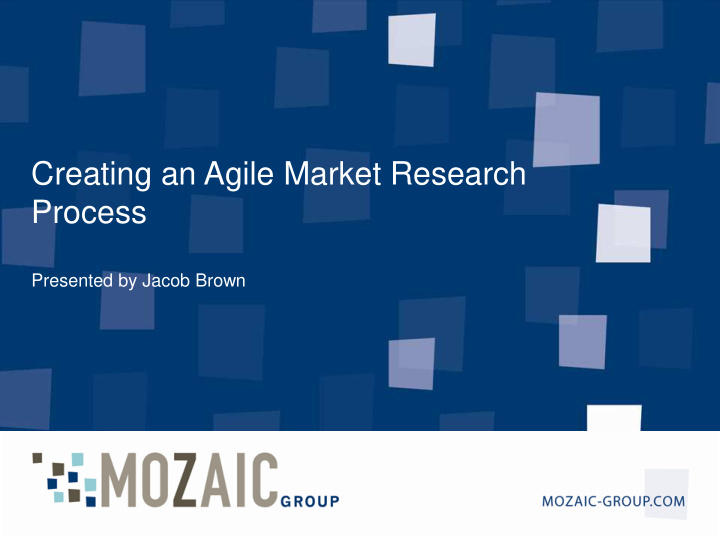



Creating an Agile Market Research Process Presented by Jacob Brown
Traditionally, Market Research and New Product Development have collaborated on the creation of new products and services.
But in many organizations, the Research and Dev groups have gotten out of sync. And the traditional process has become less and less effective.
The fault lies in trying to apply a 20 th century solution to a 21 st century problem.
This product development model was created for the stately pace of the Consumer Packaged Goods world of the 1960’s.
But, today’s Dev cycles have gotten a little faster.
To manage these faster cycles, organizations are moving from a traditional Waterfall process - to an Agile development model.
But, most research groups are still working from a Waterfall playbook.
As a result, Product Development can feel that Research is out of sync with the Sprint Cycle. Or worse, slowing down the process.
The solution lies in creating an Agile Market Research Process. Characteristics of Agile Research: Fewer questions Frequent events Flexible scheduling Focused research audience Facilitate DIY research
Fewer Questions T raditional Research Lots of questions – packs it all in. Agile Research Focuses on a few specific questions the Scrum needs to understand in order to move forward for the next Sprint.
Frequent Events Traditional Research Occasional research studies – big ticket items. Agile Research Frequent low cost sorties into the marketplace.
Flexible Schedule Traditional research The structure of traditional research creates a rigid project schedule with long lead times. Agile Research Ready when you need it.
Focused Target Traditional Research Casts a wide net – looks under every rock. Agile Research Focuses on the Prime Target: The most enabled – engaged and excited by your product. If you can’t attract them – what hope do you have of selling the less engaged. Once you’ve solved for the prime target – then you expand the scope.
Facilitate DIY Research Traditional Research Research talks to the target – Product Development stays behind the mirror. Agile Research Research Group supports Scrum Team Members talking directly with the customer/target.
Integrating a Research “Spike” into the Sprint Cycle Each Scrum will make it’s own decision on when/how to interface with the research group. But our experience suggests: Planning the Research Process: Story Time/Product Backlog Grooming are good times to identify research needs What does the team need to know to better define the User Stories in the Product Backlog? Presenting Research Findings: Sprint Planning is a good time to present the research in time for those User Stories to move into the Sprint Cycle. 17
An Example of an Agile Research Program 18
A three part research program 1: Foundational Research 2: Sprint Research 3: DIY Research 19
Foundational Research Methodology • Focus groups • Individual interviews • Online surveys Objectives • Strategic research issues • Broad market investigation • Overall response to the core concept and/or most recent build • Messaging and positioning strategy Timing • One study per quarter 20
Sprint Research Methodology • Typically, short and highly focused one-on-one interviews • Interviews may be conducted in-person or online Objectives • Answer immediate information the Scrum needs to move the product backlog forward – examples might include: • Validate User Stories • Expand User Stories • Identify feature value • Resolve UX questions Timing • Approximately every 2 – 4 weeks depending on the team’s Sprint Cycle and information needs 21
DIY Research Methodology • Mozaic trains Scrum team to conduct DIY interviews • Mozaic supports Scrum’s DIY research planning needs Objectives • Help the product team get “out of the building” and in direct contact with the “Customer” Timing • 3 – 4 times per quarter 22
An example of an Agile Research calendar Week Foundational Sprint DIY 1 Sprint Research 2 DIY Research 3 4 Sprint Research 5 DIY Research 6 Foundational Research 7 Sprint Research 8 DIY Research 9 Sprint Research 10 DIY Research 11 12 Sprint Research 23
A few slides on the Mozaic Group
Qualitative Research Naming and Capabilities Ideation Experience built through Value Message Proposition Validation thousands of groups and IDIs. Qualitative Studies Deep experience Product working with many Positioning Innovation different markets and industries. Brand Imagery Meticulous project management. 25
Online Research Online Capabilities Diaries Interactive Immediate consumer Video Package Groups insight in the store or Design home – not in a research Online facility. Methodologies Research without Online Virtual Shelf Usability Space geographic barriers. Methodologies in tune Mobile Research with how consumers communicate. 26
Quantitative Research Message Capabilities Testing Advanced multivariate Market Satisfaction Sizing techniques. Quantitative The cutting edge data Studies collection methods. Brand Powerful market Pricing Equity segmentation and pricing models. Market Demand 27
Global Research In-Person Capabilities Qualitative Premier Multi- Research on six Local Language continents and in over Partners Surveys 30 countries. International Studies A single point of contact for your global project. Remote Emerging Qualitative Markets Premier local partners anywhere in the world. Europe and Asia 28
Some of the markets we serve Boomers & Seniors Retail Enterprise Technology Teens and Tweens Financial Services Consumer Technology 29
A Few of Our Clients 30
Recommend
More recommend